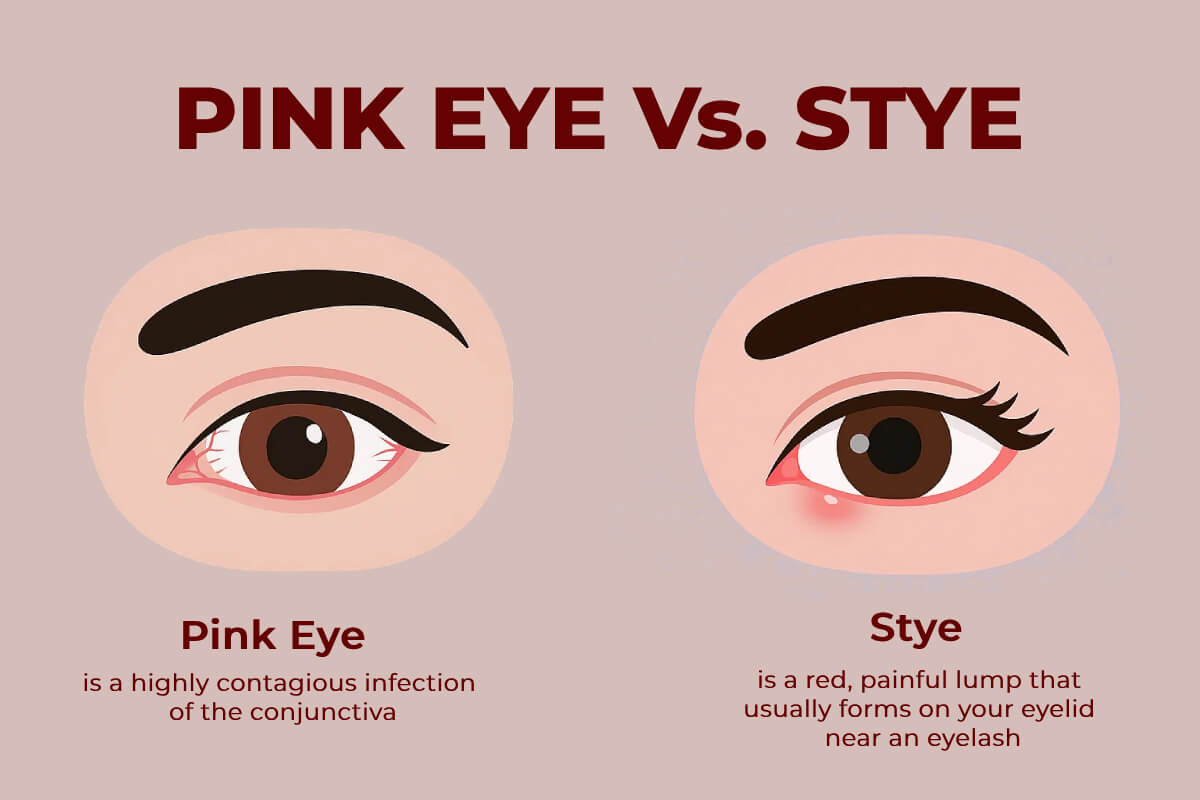
Last Updated on June 27, 2025 by Aaron Barriga
As you experience eye discomfort, you may wonder if it’s pink eye or a stye causing your irritation. It can be challenging to tell these eye conditions apart, but understanding the differences between them is essential to receive proper treatment. At Insight Vision Center, we provide comprehensive eye care services, including treatment for pink eye and stye.
Let’s take a closer look at the symptoms, causes, and treatments for these eye problems.
What is Pink Eye?
Pink eye, also known as conjunctivitis, is a highly contagious infection of the conjunctiva, the thin, transparent lining of the eyelid. Pink eye infection inflames the small blood vessels, making them more visible and giving the white portion of your eye a reddened hue. This condition is commonly caused by bacteria, viruses, or allergies.
What is Stye?
A stye, or hordeolum, is a red, painful lump that usually forms on your eyelid near an eyelash. It is caused by a bacterial infection that occurs when a clogged oil duct leads to bacterial buildup. The lump can last a few days without any treatment. In some cases, the stye may be deeper in the eyelid and require medical attention.
What is the Difference Between Pink Eye and a Stye?
Both pink eye and stye share similar symptoms, such as itching, redness, and soreness. However, a lump on the eyelid is a unique indication of a stye. It can be challenging to differentiate between conjunctivitis (pink eye) and a stye, particularly in the early stages.
Symptoms of Pink Eye vs Stye
What are the Symptoms of Pink Eye?
- Redness in the eye and the surrounding area
- Sticky discharge from the eye
- Irritation in the eye
- Inflammation in the eye
- Itching in and around the eye
- Watering eyes
What are the Symptoms of a Stye?
- Redness in the eye
- Tenderness in the eye
- Inflamed eyelid
- Crusty discharge from the eye
- Eyelids hanging down
- A small, reddish, and sometimes painful bump on the eyelid
Causes of Stye Eye vs. Pink Eye
The critical difference between pink eye and a stye is the cause behind each condition. Although both are common eye infections, their causes are quite different.
What are the Causes of Conjunctivitis?
The three primary forms of conjunctivitis are viral, allergic, and bacterial. Each can come from different sources. Nonetheless, some of the most frequent causes of pink eye are as follows:-
- Viral infections like the flu or a cold
- Triggered allergies from chemicals, dust, smoke, pollen, etc.
- Bacterial infection
- Foreign objects falling inside the eye
- Exposure to irritants such as cleansers, contact lenses, or cosmetics
What are the Causes of a Stye?
A stye is an inflammation or infection at the base of an eyelash follicle or oil gland on the eyelid that is caused by bacteria. You can be at risk of getting a stye if you do things like:
- Sleeping with eye makeup on
- Rubbing and touching your eyes too often
- Maintaining overall poor eye hygiene
- Wearing contact lenses longer than their ideal duration
Treatment for Pink Eye vs. Stye
Viral or bacterial pink eye and stye usually resolve on their own in one to two weeks. However, seeking medical attention from an eye specialist is recommended if the symptoms aggravate, affect eyesight, or alter the appearance of the eyes.
What are the Treatment Options and Remedies for Pink Eye?
- Apply warm or cold compresses
- Avoid wearing eye makeup and contact lenses until your pink eye gets cured
- Take allergy medications if needed
- Get OTC pain relievers, eye drops, or ointments if you feel discomfort
- Ask your doctor if antihistamines can help you avoid the symptoms of pink eye.
- Also, remember not to share your things, like a towel and linens, with anyone to avoid spreading the infection
What are the Treatment Options and Remedies for a Stye?
- Apply warm compresses to the eyes and the eyelids
- Don’t wear contact lenses or eye makeup when you have a stye
- No matter how tempting, never pop a stye
- Get the OTC pain reliever and eye ointment if required
- In chronic cases, you may need to take prescribed medicines, get a steroid shot, or even surgically remove the stye. However, these are all rare scenarios.
Preventing Conjunctivitis and Stye
At Insight Vision Center, we believe that preventing eye infections is an essential part of maintaining good eye health. While it’s not always possible to avoid getting pink eye or a stye, following some simple preventive tips can help reduce your risk of getting these infections.
How to Prevent Pink Eye?
- Wash your hands before and after touching your eyes to avoid getting pink eye.
- Avoid allergens that could give you pink eye if you are prone to allergies.
- If you have pink eye in one eye, avoid touching your other eye, and don’t share towels, washcloths, or eye makeup to prevent the infection from spreading.
- To prevent reinfection, avoid using contact lenses while your pink eye is still present, and do not reuse the pair you were wearing when it first appeared.
- After your condition improves, wash your towels and pillowcase to prevent getting pink eye again.
How to Prevent a Stye?
- Wash your hands frequently with soap and water, especially before inserting or removing contact lenses or wiping your eyes.
- Discard eye creams or makeup after a few months, and don’t let anyone else use your eye products.
- Taking good care of your contact lenses can also help ensure hygiene.
- Avoid rubbing your eyes, as it can transfer bacteria from your hands to your eyes.
Remember, if you suspect you have pink eye or a stye, it’s best to consult an eye specialist to get an accurate diagnosis and appropriate treatment plan.
At Insight Vision Center, we are always ready to provide you with the best possible care for your eyes.
FAQs – Pink Eye vs. Stye
Related Blog Post:

Dr. Azhar I. Salahuddin is an ophthalmologist and is fellowship-trained in cornea, external diseases, and refractive surgery. Dr. Salahuddin has been performing cataract surgery for over 19 years and specializes ocular reconstruction, corneal transplantation surgery as well as vision correction through a variety of intraocular lenses. Dr. Salahuddin is board-certified by the American Board of Ophthalmology and was trained at Boston University.

